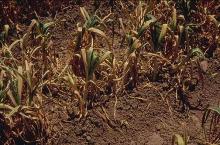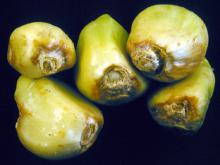Cause Ditylenchus dipsaci, several strains of which are known to be in Oregon. The only known hosts for the garlic strain belong to the onion family: garlic, onion, leek, and chive. However, it also attacks Shasta pea, parsley, celery, nightshade, and salsify.
The host usually is invaded through natural openings, but these nematodes also can provide their own avenue of entry. Once established, they move through tissues of host plants, break down cell walls, and feed on cell contents. They attack the plant's basal plate. Nematodes can live in stored plant tissue at least 9 years but decline rapidly in soil. They spread principally through planting infected stock. They are carried beneath the protective leaf and abscission layer (where the clove attaches the main stem).
Symptoms Diseased cloves generally show no symptoms but can be detected by examining tissue microscopically. In the field, top growth yellows and ripens prematurely. The whole bulb may separate from the basal plate. In severe cases, cloves will break down into a spongy mass due to secondary rotting organisms, leaving little evidence of cloves or bulbs at harvest time. Under cool growing conditions, affected plants may show few or no symptoms. High temperatures bring on symptoms quickly.
Cultural control
- Eradicate volunteer garlic plants from fields having a history of bulb or stem nematode.
- Avoid other hosts of the nematode in your rotation if possible.
- Do not plant garlic at least 2 years in fields known to be infested with bulb or stem nematode.
- Plant only nematode-free cloves.
- Soak cloves at 100°F for 30 min. in water containing 0.1% surfactant; then soak at 120°F for 20 min. in the same kind of solution. Cool cloves in tap water for 10 to 20 min. before drying for 2 hr at 100°F, or plant if possible. This helps eradicate the bulb or stem nematode from loose (cracked) cloves but not from intact bulbs.
Chemical control
- Vydate L in Oregon, California, and Washington only (SLN WA-000018). See label for directions. 48-hr reentry. Restricted-use pesticide.
Reference Lear, B., and Johnson, D.E. 1962. Treatments for eradication of Ditylenchus dipsaci in cloves of garlic. Plant Disease Reporter 46:635-639.



